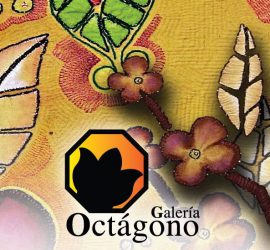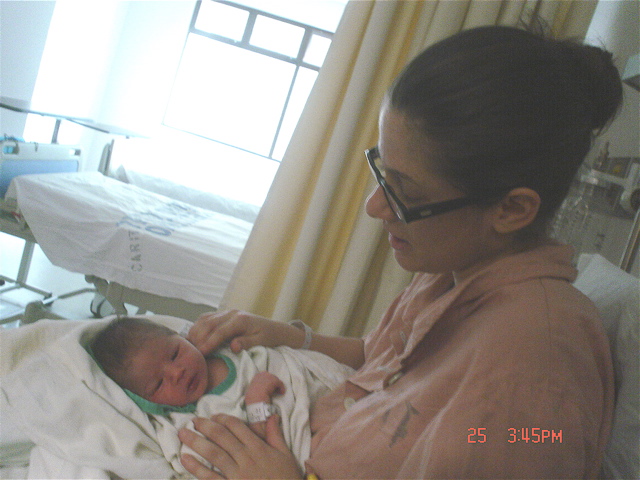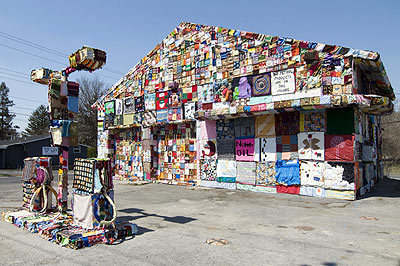PARA LA BEBE DE CRISTI – For Cristi’s Baby
ETAPA 1: Instrucciones  STAGE 1: Instructions
STAGE 1: Instructions
Instrucciones en hebreo. Hebrew instructions: s-baby.doc s-baby
2. Escoja tela cuyo tema no está impreso con dirección específica.
Por ejemplo, si la tela tiene líneas, todos los bloques de la quilt deberán ir hacia un mismo lado, por lo cual este tipo de tela no se presta para este proyecto.
Choose prints whose theme doesn’t have a specific direction.
For example, if the fabric has stripes, all quilt blocks should go in the same direction; therefore, this type of print isn’t good for this project.
3. Marque los 20 bloques por el revés.
Yo dejo márgenes grandes, por si acaso la tela se deshilacha un poco al manipularla por tantas personas.
Mark the 20 blocks on the wrong side of fabric.
I leave big margins just in case the fabric gets frayed when manipulated by so many people.
4. Distribuya los bloques a familiares y amigos, quienes tendrán libertad de expresarse por medio de appliqué, bordado o pintura.
Asegurarse de no poner botones o relieves que el bebé puede tragarse.
Distribute the blocks amongst relatives and friends, who will have freedom of expression by way of appliqué, embroidery, or painting.
Make sure not to attach buttons, or protruding things that baby could swallow.
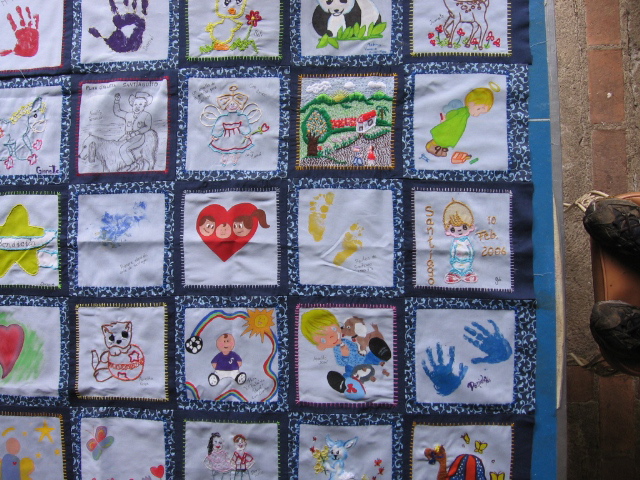
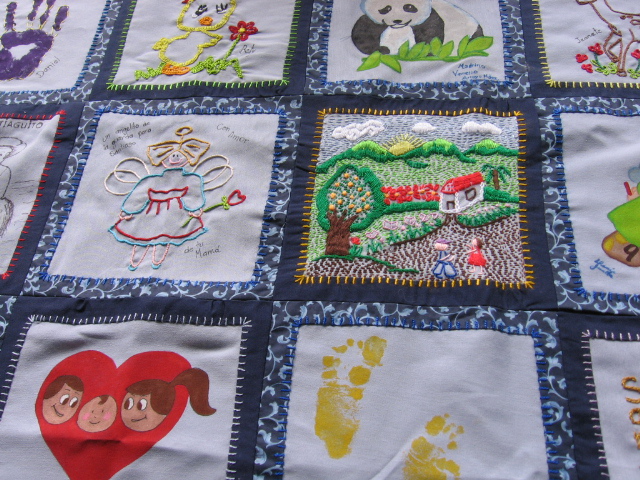
5. Termine de hacer la quilt cuando todos los cuadros estén terminados.
Finish making the quilt once all the blocks are ready.
Quilt de la bebé de Emily – Emily’s Baby Quilt
La pequeña Eleanor nació el 2 de junio. Aquí posan su mami y abuela con la quilt.  Little Eleanor was born on June 2nd. Her mom and grandmother pose here with the quilt.
Little Eleanor was born on June 2nd. Her mom and grandmother pose here with the quilt.
Para este proyecto enviamos los bloques a familiares y amigos de Emily y Dan en Canadá y EEUU. Luego hicimos la quilt de pared, pues algunos bloques son algo peligrosos para la bebé, ya que no fueron bien pegados, o tienen protuberancias.
For this project we sent blocks to Emily’s and Dan’s relatives and friends in Canada and the U.S.. Then, we made a wall quilt, because some of the blocks are dangerous to the baby since they weren’t properly sewn, or have protruding elements.
Al final, le hicimos un libro de tela, con recuerdos de este proyecto.
At the end, we made her a fabric book with mementos of the project.
Y como a abuelita Dorothy le encantan los camellos, le hicimos nueve camellos de tela (¡lavables!).
And since grandma Dorothy loves camels, we made her nine cloth camels (they’re washable!)
¿POR QUE BLANCO Y NEGRO?
Blanco y negro es la “etapa zebra”: lo primero que distinguen y aprecian los bebés.
WHY BLACK & WHITE?
Black & white is the “zebra stage”—the first thing babies can see and appreciate.
EXHIBICIONES 2009 / EXHIBITS 2009
https://www.flickr.com/photos/thedreamrocket/albums/72157625848556452/
“INTERDEPENDENCE”
Huntsville, AL. The International Fiber Collaborative announces its 2008–2009 project, Interdependence, a full-sized tree for display in April 2009. Entrants are encouraged to be creative in deciding on materials and techniques, and may paint, stitch, crochet, patch, quilt, knit, or glue (water resistant glue). Each leaf should measure roughly 5 in. wide (at its thickest) x 7 in. long. Leaves may also have shape and dimension. Submissions may relate to interdependence in a social, economical, political, ecological, or geographical way. The tree’s trunk and branches will all be wrapped with handmade fiber sleeves. The application deadline is March 15, 2009.
PRIMER GRUPO DE 100 HOJAS ENVIADAS PARA ESTE PROYECTO: hechas por Silvia Piza-Tandlich y la Colectiva Cerro Danta.
FIRST BATCH OF 100 LEAVES SENT FOR THIS PROJECT: MADE BY SILVIA PIZA-TANDLICH AND THE CERRO DANTA COLLECTIVE.
“Interdependencia”
Huntsville, Alabama. La Colaborativa Internacional de Fibras anuncia su proyecto Interdependencia para la temporada 2008-2009. Los participantes van a crear un árbol de tamaño real, para ser mostrado en abril de 2009 en el parque Big Springs International Park. Al igual que un árbol real es interdependiente de sus raíces y hojas para sobrevivir, las sociedades son interdependientes principalmente de las unidades familiares, las comunidades y los países. Los participantes de todo el mundo pueden crear hojas y contribuir en la creación de este árbol. En total, se usarán 30.000 hojas, las cuales deberán ser confeccionadas usando fibra o técnicas de fibra. Alentamos a los partícipes a mostrar su creatividad al escoger materiales y técnicas. Pueden pintar, coser, hacer crochet, parches, quilt, tejido o pegamento (si usan pegamento resistente al agua). Cada hoja deberá medir 12cm en su parte más ancha X 17cm de largo. Las hojas pueden tener formas y dimensiones. Las obras participantes pueden relacionarse a la interdependencia en lo social, económico, político, ecológico o geográfico. El tronco y ramas del árbol serán envueltos en mangas de fibra hechas a mano.
Silvia Piza-Tandlich: More Mixed Media Textile / Más técnica textil combinada
Silvia Piza-Tandlich: Mixed Media Textile / Textil técnica combinada
“TILICHES” / Hanging Trinkets
“Tiliches” is the Costa Rican word for hanging trinkets.
This is a small part of our [large] installation, which has taken us several weeks to complete. Every Saturday, the youngsters and their moms spend the entire afternoon creating the cardboard disks, which Silvia later turns into hanging garlands.
“TILICHES” ES LA PALABRA COSTARRICENSE PARA CHUCHERÍAS QUE CUELGAN.
ÉSTA ES UNA PEQUEÑA PARTE DE NUESTRA [GRAN] INSTALACIÓN, LA CUAL NOS HA TOMADO VARIAS SEMANAS EN COMPLETAR. CADA SÁBADO, LOS JÓVENES Y SUS MADRES PASAN TODA LA TARDE CREANDO LOS DISCOS, LOS CUALES SILVIA CONVIERTE EN GUIRNALDAS COLGANTES.
COLABORATIVA INTERNACIONAL DE FIBRAS – INTERNATIONAL FIBER COLLABORATIVE
International Fiber Collaborative: https://ifcprojects.com/about-international-fiber-collaborative/
Silvia and our Cerro Danta collective presented five panels to the fiber collaborative in Syracuse, NY. This is a gigantic installation measuring 800 square yards! Artists from 16 countries are present to protest our world’s dependency on petro oil.
SILVIA Y LA COLECTIVA CERRO DANTA PRESENTARON CINCO OBRAS A LA COLABORATIVA DE FIBRAS EN SYRACUSE, NUEVA YORK. ESTA INSTALACION ES GIGANTESCA: MIDE 800 YARDAS CUADRADAS (¡CASI UN KILOMETRO CUADRADO!) Y COMPRENDE ARTISTAS DE 16 PAISES: TODOS ELLOS PRESENTES PARA PROTESTAR NUESTRA DEPENDENCIA MUNDIAL DEL PETROLEO.
Our quilts will be displayed until June, 2008, covering an abandoned gas station.
NUESTRAS QUILTS SERÁN MOSTRADAS HASTA JUNIO DEL 2008, CUBRIENDO UNA GASOLINERA ABANDONADA.
Membrana Verde:
Burlap Membrane:
“No Mo Oil” (appliqué on felt)
“We Love Nature” – Appliqué & painting over cotton mesh
“AMAMOS LA NATURALEZA” – APPLIQUÉ Y PINTURA EN TELA ALGODÓN
Go to the site and enjoy seeing all the artwork submitted!
¡VAYA A ESTE SITIO Y DISFRUTE VIENDO LAS OBRAS DE ARTE QUE SE PRESENTARON!
www.internationalfibercollaborative.com
———————————————————————————————–
REVISTA Fiberarts MAGAZINE
http://www.fiberarts.com/back_issues/Nov-Dec-2008/wrap.asp
November/December 2008
The World Reclamation Art Project (WRAP)
In our November/December 2008 issue, we included Jennifer Marsh’s World Reclamation Art Project (WRAP), a gas station cozy created to address the world’s dependence on petroleum. For the project, Marsh received individual squares from thousands of people around the world that she combined to make the cozy. Here Marsh tells the stories of three of the contributors, including Fiberarts Assistant Editor Liz Good.
The World Reclamation Art Project on display in DeWitt, New York (just outside Syracuse), April 12th – July 1, 2008. Photo: Cathryn Lahm.
Story #1
Silvia Piza-Tandlich is a textile artist and the founder and director of Octágono Gallery in Costa Rica. The gallery is a community-based program that provides educational and income opportunities through the textile arts. Silvia and her group joined the project to express their concerns towards our world’s dependency on petroleum. In total, her group donated five truly inspiring panels. Silvia shared with me a story about another participant, whom she met through the IFC, that lived in Argentina. She said this amazing woman had been fighting cancer but was struck by our community textile-based project on oil dependency and was driven to complete a panel. Silvia said the ill woman had to take breaks and rest her arms in ice as she was finishing her panel. Wow! That is just amazing and inspiring.
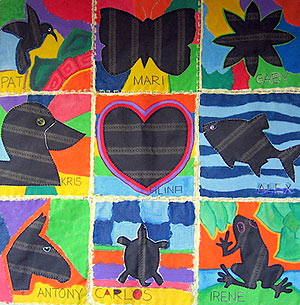
Fiberarts Magazine, The Octágono Gallery group (Costa Rica), Untitled, 2008; painted, stitched; 3′ x 3

